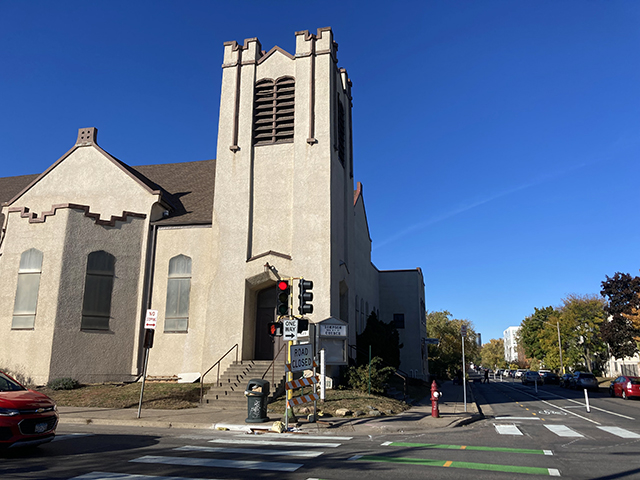Last week, the Minneapolis City Council joined Hennepin County in helping to fund an effort to create more transitional housing for the area’s homeless.
The project, run by Simpson Housing Services and located at the corner of 1st Ave and 28th Street in the Whittier neighborhood, will increase the size of the organization’s current one-level shelter to five stories. And though the number of shelter beds offered now — roughly 70 — won’t change, the new space will dedicate the majority of the shelter’s beds into supported housing, which will include a suite of services to access affordable housing, mental health and chemical dependency treatment, job placement, and more.
The city and county together provided $7 million toward the $35 million project. Hennepin County contributed $3.5 million while Minneapolis added another $3.5 million — all of it coming out of funds received by the local governments under the federal American Rescue Plan.
“These 42 additional units are critical, the 70 units of emergency shelter are really important, but here’s the thing: we need to keep our nose to grindstone on the very important issue of housing, because housing is a right,” said Minneapolis Mayor Jacob Frey at a press conference called to announce the project earlier this week.
Meanwhile, Hennepin County Commissioner Angela Conley, who also spoke at the press conference, said that she is not done trying to secure additional funding for the project. “Hennepin County allocated $3.5 million,” she said, “I’d like to get to $30 [million] to ensure that Simpson can continue to provide this critical, emergency shelter into the future.”

[image_credit]MinnPost photo by Solomon Gustavo[/image_credit][image_caption]Mayor Jacob Frey speaking at a press conference earlier this week: “We need to keep our nose to grindstone on the very important issue of housing, because housing is a right.”[/image_caption]
“We all want to move toward a re-envisioned shelter system that is person-centered, that connects people to the services they need to move into housing,” said Andrea Brennan, director of Minneapolis Community Planning and Economic Development (CPED). “Because the solution is housing, it’s not shelters. It’s making sure we have the kind of welcoming places that people are comfortable as they can be and participate and receive services.”
In 2019, shortly after the Navigation Center closed, Simpson Housing planned to lobby the state for funds to renovate the current shelter. Yet Simpson Executive Director Steve Horsfield said the pandemic curtailed those ambitions, slowing down “any hope for getting what we thought we needed from the state Legislature.” With the availability of American Rescue Plan money for the city and county, however, “we found an alternate solution.”

[image_credit]MinnPost photo by Solomon Gustavo[/image_credit][image_caption]Hennepin County Commissioner Angela Conley, who also spoke at the press conference, said that she is not done trying to secure additional funding for the project.[/image_caption]
The shelter first opened nearly 40 years ago as a project of the bygone Simpson United Methodist Church, which no longer holds services and has evolved into a shelter-only operation.
Today, the shelter still operates out of the windowless basement of the building — long past anyone’s intentions, said Horsfield.
When Simpson Housing began setting specific plans for the expansion three years ago, said Horsfield, it partnered with the Minneapolis-based Project for Pride in Living, which has extensive experience managing housing and career readiness programs.
Alongside converting 42 of the 70-or-so shelter beds into more permanent, transitional housing, the new shelter will not have bunk beds or crowded sleeping quarters. The reason the number of beds won’t increase in the new facility is due to another lesson gleaned from running the Navigation Center, said Horsfield: the organization found that anything over about 80 beds inhibits the ability to provide one-on-one services to clients.
There will only be between six and 12 beds in a room, said Horsfield. And the rooms will be designed to offer maximum flexibility so that sub-spaces can be created within the shelter, potentially for gender-specific or non-binary groups.

[image_credit]MinnPost photo by Solomon Gustavo[/image_credit][image_caption]The shelter first opened nearly 40 years ago as a project of the bygone Simpson United Methodist Church, which no longer holds services and has evolved into a shelter-only operation.[/image_caption]
Simpson Housing scheduled the demolition of the current shelter at the end of 2022. While construction work is being done, the shelter will be housed in another location, which has yet to be determined, said Horsfield. The new facility is set to open in 2024.





